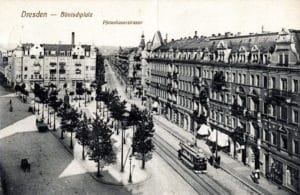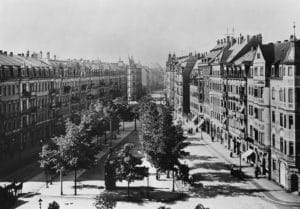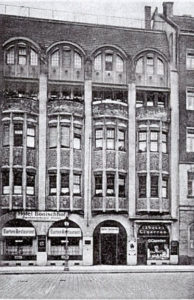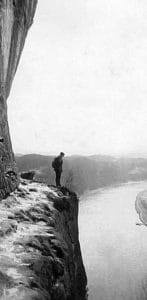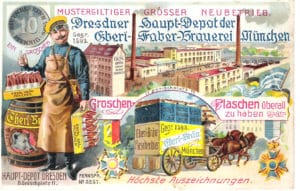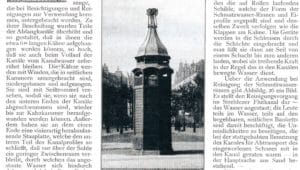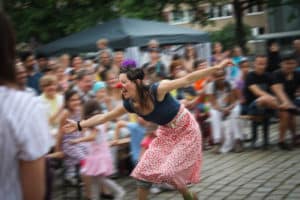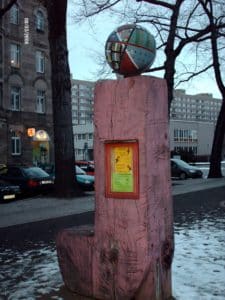Diese Seite ist mehrsprachig verfügbar: English, Русский, عربي.
Folgen Sie der ehemaligen Blumenstraße bis zur Bundschuhstraße und überqueren Sie diese. Am Bönischplatz erreichen Sie den Standort Nr. 8 des historischen Rundwegs.
Vor 1945: Bönisch, Bier und Bastei
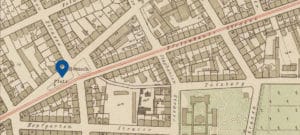
Anlage des Bönischplatzes
1897 wurde die Pfotenhauerstraße begradigt und bis zur Elisenstraße fortgeführt. Der dabei entstandene Freiraum zur Blumenstraße wurde zum Bönischplatz. Seinen Namen erhielt der Platz vom Dresdner Bürgermeister, Stadtrat und Juristen Karl Friedrich Emil Bönisch (1832–1894), der auch in unmittelbarer Nähe wohnte. Als Mitglied der II. Ratsabteilung war Bönisch u. a. für das Stadtkrankenhaus und das Bürgerhospital (heute DRK Pflege- und Seniorenheim Clara Zetkin auf der Pfotenhauerstraße) zuständig.
Infolge der städtebaulichen Ausrichtung des Straßenrasters mit teilweise im spitzen Winkel angelegten Verläufen ergaben sich in der Johannstadt eine Reihe von dreieckigen Plätzen, die alle mit einer Grünfläche gestaltet und vollständig von Wohngebäuden umrahmt waren. Kriegsbedingt ist davon heute nur noch der Bönischplatz erhalten.
Weitere Informationen zur Geschichte des Bönischplatzes finden Sie hier.
Ab 1893 fuhr die Straßenbahnlinie 18 als erste elektrische Bahn Sachsens über die Pfotenhauerstraße nach Blasewitz. In der Hertel-, Burckhardt- und Neubertstraße befand sich eine selten genutzte Gleisschleife.

Rechts: Verlauf der Linie 18 in der Johannstadt und Gleisschleife Hertelstraße im Stadtplan von 1911. Quelle: SLUB Dresden / Deutsche Fotothek
Gewerbe am Bönischplatz
Am Bönischplatz Nr. 9 öffnete 1905 das Hotel und Restaurant Quack. Von 1908 bis 1920 befand sich hier auch ein kinematographisches Theater (Kino). 1922 übernahm der Gastronom Emil Max Rahm (1872–1952) das Restaurant und benannte es in Bönischhof um. Rahm arbeitete zuvor im Basteihotel und gilt als Erstbesteiger der Rahm-Hanke in der Sächsischen Schweiz unterhalb der Bastei.
1907 verlagerte das Dresdner Hauptdepot der Münchner Brauerei Eberl Bräu, später Paulaner, seinen Firmensitz von der Holbeinstraße an den Bönischplatz Nr. 11. Auf einer Fläche von 3.500 Quadratmetern befanden sich Wohn- und Betriebsgebäude, Kessel- und Maschinenhaus sowie ein Kühlraum aus Stahlbeton. Mit sechs Flaschenfüllanlagen wurden in einer 10-Stunden-Schicht 10.000 Flaschen gereinigt, abgefüllt und etikettiert.
Im Innenhof hinter dem Bönischplatz Nr. 7 entstand 1932 eines der ersten privat betriebenen Parkhäuser Dresdens mit einer Kapazität von etwa 120 Fahrzeugen.
Nach 1945: Trümmer, Tabak, Trubel
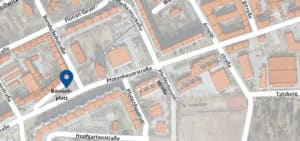
Unten: Ruinen am Bönischplatz 1945. Foto: unbekannt, aus der Sammlung JohannStadtArchiv
Zerstörung und Wiederaufbau
Bei den Bombenangriffen vom Februar 1945 wurde die gesamte Süd- und Nordostseite des Platzes zerstört. Von der ursprünglichen Gründerzeitbebauung sind nur die vier Häuser Nr. 11-17 verblieben. Außerdem sind zum Stand 2018 noch fünf der 1879 gepflanzten Bäume erhalten.
Ab 1970 begann der Wiederaufbau des Bönischplatzes mit zehngeschossigen Wohngebäuden auf der Südseite. 1973 entstand das Hochhaus am Bönischplatz (heute Pfotenhauerstraße 5) als erster 15-Geschosser des Neubauprogrammes Johannstadt. Dabei wandelte sich die frühere Ostseite des Bönischplatzes östlich der Bundschuhstraße in eine Rasenfläche. Als Platzfläche sichtbar ist daher heute nur noch der spitze Westteil. 1982 entstanden die Gebäude am Bönischplatz Nr. 5, 7 und 9 als Lehrlingsbauten des Kombinats BMK Energie und Kohle. 2017 begann an der Südwestseite des Bönischplatzes die Errichtung des Güntzareals.
Weitere Informationen zur Geschichte des Bönischplatzes finden Sie hier.
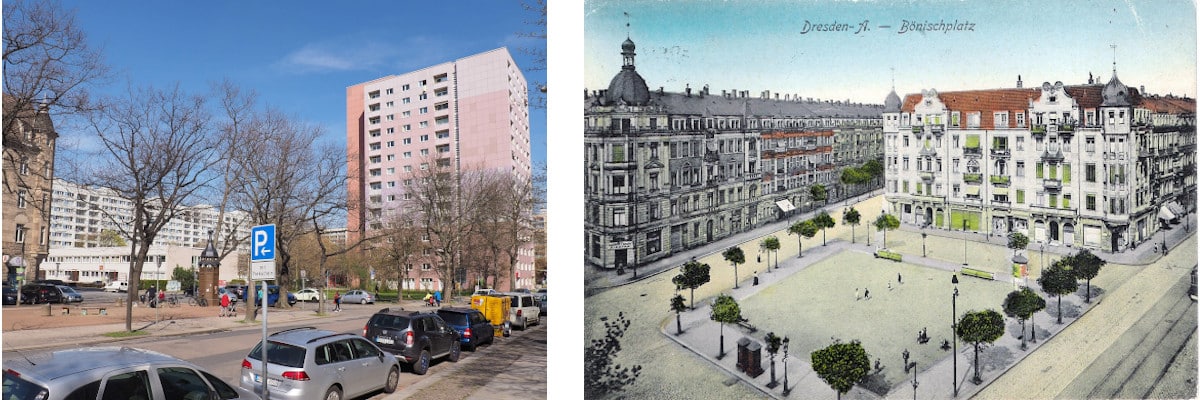
Rechts: gleicher Blickwinkel, vor 1945. Foto: unbekannt, aus der Sammlung JohannStadtArchiv
Exakt an der Stelle des Hochhauses befanden sich vor der Zerstörung die markanten Kopfhäuser.
Ein lebendiger Platz
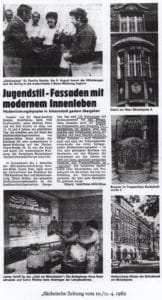
Auch zu DDR-Zeiten gab es eine vielfältige gewerbliche Nutzung am Bönischplatz. Zu den zahlreichen ansässigen Einrichtungen zählten u. a. Reparaturwerkstatt, Friseur, Drogerie, Schuhladen, Obst- und Gemüseladen, Tabakladen, Optiker, Künstleratelier, das Café am Bönischplatz und eine Altpapiersammelstelle. Von 1997 bis 2003 befand sich am Bönischplatz zudem der von Werner Ehrlich betriebene Stadtteilladen, der die Johannstadt mit einer Reihe von Kulturaktionen bereicherte. 2003 erfolgte eine erste Verschönerung des Platzes, bei der u. a. neue Bänke und die Holz-Keramik-Plastik von Andreas Rode und Thomas Wieduwilt zum Einsatz kamen, die auf den Johannstädter Kulturtreff hinweist. Die Plastik ist bis heute erhalten. Im Ergebnis einer intensiven Bürgerbeteiligung erfolgt 2020 eine grundlegende Neugestaltung des Platzes, um ihn als lebendigen Stadtteilplatz besser nutzen zu können, z. B. für das seit 2015 jährlich stattfindende Bönischplatzfest.
|
|
Text: Matthias Erfurth, Matthias Kunert, Henning Seidler
Redaktionsschluss: März 2021

